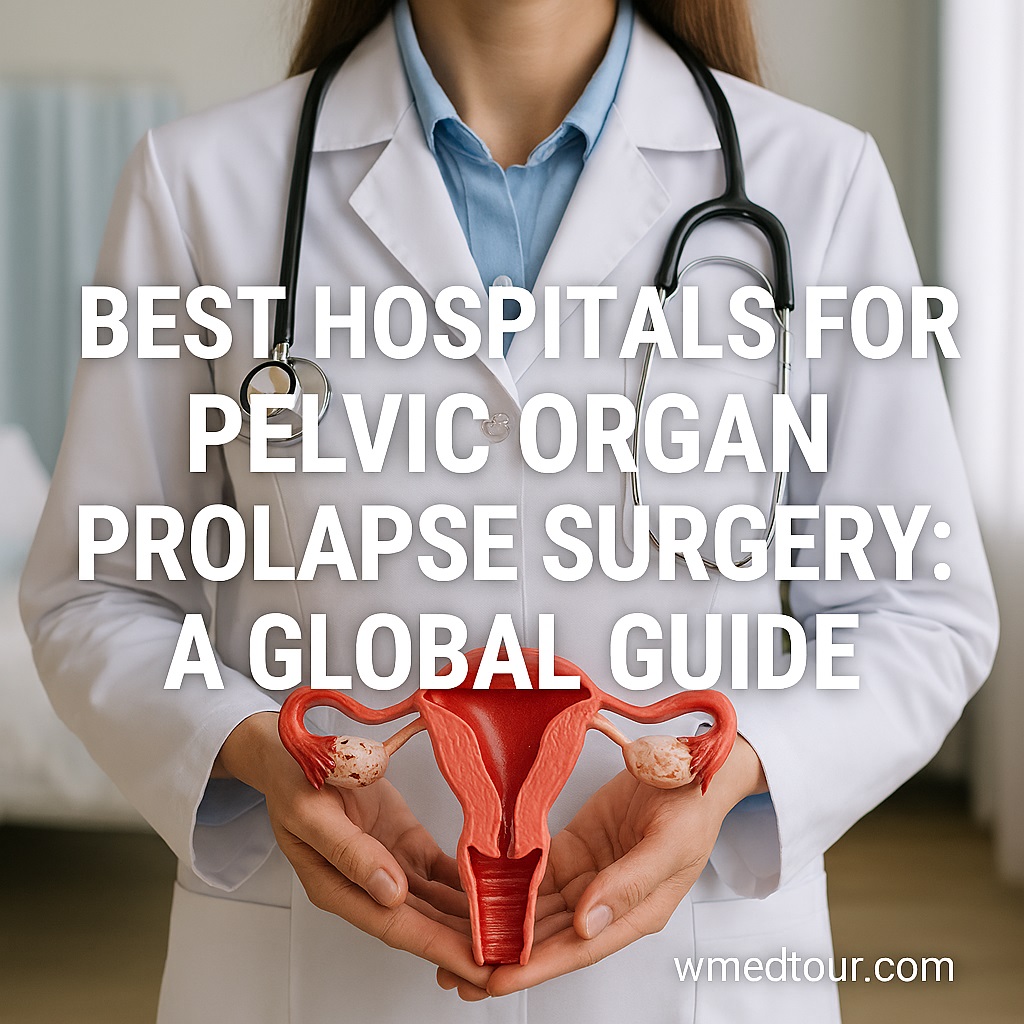Best Hospitals for Pelvic Organ Prolapse Surgery: A Global Guide
For many women, pelvic organ prolapse (POP) can be a challenging and uncomfortable condition. It occurs when the pelvic floor muscles and tissues weaken, causing organs like the bladder, uterus, or rectum to drop into the vagina. Furthermore, while lifestyle changes and physical therapy can help in early stages, surgery often becomes the most effective and definitive treatment. As a result, finding the **Best Hospitals for Pelvic Organ Prolapse Surgery** is a critical first step on your journey to recovery. This guide will walk you through what to look for in a world-class hospital and help you find the right care.
First and foremost, it’s essential to understand that not all hospitals offer the same level of expertise. In fact, many medical centers are general in nature and may lack a dedicated team of urogynecologists, specialists who focus on pelvic floor disorders. Therefore, finding a hospital with a specialized center of excellence can make a significant difference in your surgical outcomes and long-term quality of life. In addition, selecting the right hospital is about more than just a famous name; it involves evaluating its specific experience, technology, and patient care philosophy.
Understanding Pelvic Organ Prolapse and Treatment Options
Pelvic organ prolapse is a common condition that affects millions of women worldwide. It can cause a range of symptoms, including pelvic pressure, urinary incontinence, and sexual discomfort. Furthermore, while there are different stages of prolapse, the treatment options are varied. Non-surgical options include pessaries, which are medical devices inserted into the vagina, and pelvic floor muscle training. However, for more advanced prolapse, surgical intervention is generally the most effective way to restore the pelvic organs to their proper position.
Types of POP Surgery and Techniques
Surgical approaches for POP vary depending on the specific organs involved and the severity of the prolapse. For example, some procedures use a patient’s own tissues to repair the pelvic floor, while others may utilize surgical mesh. In recent years, minimally invasive techniques such as laparoscopic and robotic-assisted surgery have become standard. These methods offer several advantages, including smaller incisions, less pain, and a faster recovery time compared to traditional open surgery. Consequently, when searching for the **Best Hospitals for Pelvic Organ Prolapse Surgery**, inquire about their experience with these modern techniques.
What Makes a Hospital the “Best” for Pelvic Organ Prolapse Surgery?
Selecting a hospital is a deeply personal decision, but several key factors indicate a high level of expertise and quality. First, look for hospitals that are recognized for their urogynecology or women’s health programs. These designations often signify a commitment to specialized care and research. Second, consider the volume of procedures a hospital performs. High-volume centers often have more experienced surgeons and better overall outcomes. For instance, a hospital that performs several hundred POP surgeries a year is likely more experienced than one that performs only a handful.
The Importance of a Multidisciplinary Team and Technology
Another crucial factor is the presence of a multidisciplinary team. The **Best Hospitals for Pelvic Organ Prolapse Surgery** will have a team that includes not just surgeons, but also physical therapists, nurse practitioners, and pain management specialists. This collaborative approach ensures that you receive holistic care, from diagnosis to post-operative recovery. Furthermore, state-of-the-art technology is a significant advantage. Hospitals that invest in advanced imaging equipment and robotic surgical systems demonstrate a commitment to providing the most effective and safest treatment options available. You can read more about surgical teams from the American College of Surgeons.
Leading Hospitals and Centers of Excellence Globally
While we cannot provide a definitive list, several hospitals and medical centers worldwide are widely recognized for their excellence in urogynecology and pelvic reconstructive surgery. These institutions often serve as referral centers for complex cases and are at the forefront of research and innovation. For instance, in the United States, places like the Cleveland Clinic and Mayo Clinic are known for their comprehensive women’s health programs. Similarly, world-class centers in countries such as the United Kingdom, Germany, and Thailand attract international patients for their specialized expertise and advanced care.
The best hospitals for pelvic organ prolapse surgery often have a strong focus on patient education and support. Therefore, they will provide you with all the information you need to make an informed decision and prepare for your surgery. In addition, many of these hospitals are actively involved in clinical trials and research, which means they can offer access to the latest treatments and techniques. As a result, choosing a center like this can give you confidence in your care. You can find more information on clinical trials from the National Institutes of Health.
Choosing the Right Surgeon for Your POP Surgery
Although the hospital is important, the surgeon you choose is arguably the most critical factor in your success. You need a surgeon with extensive experience in pelvic reconstructive surgery. Consequently, always ask about your surgeon’s credentials and experience. Look for a board-certified urogynecologist with specific fellowship training. It’s also wise to ask about their patient outcomes, including success rates and complication rates for the specific procedure you need. Furthermore, a good surgeon will take the time to answer all your questions and explain the risks and benefits of all your options.
Key Questions to Ask Your Surgeon
When you have your consultation, come prepared with a list of questions. For example, ask about the number of pelvic organ prolapse surgeries they perform each year. Also, inquire about their preferred surgical techniques and why they recommend a specific procedure for your case. Finally, ask about the expected recovery time and what kind of post-operative care and follow-up they provide. By having an open and honest conversation with your surgeon, you can build trust and feel more confident about your treatment plan. The American College of Obstetricians and Gynecologists is a great resource.
Navigating Global Medical Tourism for POP Surgery
Many patients consider traveling abroad to find the **Best Hospitals for Pelvic Organ Prolapse Surgery**. In fact, medical tourism can offer access to high-quality care at a more affordable cost. However, it requires careful planning. First, research hospitals and doctors thoroughly. Second, ensure the hospital is accredited by a recognized international organization. Finally, coordinate with a medical tourism facilitator who can help with all the logistics, including travel, accommodation, and communication.
The benefits of medical tourism for POP surgery are numerous. For example, some countries specialize in specific types of procedures or have shorter waiting times. Likewise, the overall cost of treatment, even with travel expenses, can be significantly lower. Despite these benefits, it’s important to prepare properly. Consequently, ensure you have a clear understanding of the full cost and what is included in the package. A well-planned medical trip can provide access to world-class care that might not be available at home.
Comparison of Key Factors in Hospital Selection
| Factor | High-Volume Hospital | General Hospital |
|---|---|---|
| Surgical Expertise | High, with dedicated urogynecology teams | General, with varied surgical experience |
| Technology & Equipment | Advanced laparoscopic and robotic systems | Standard surgical tools |
| Multidisciplinary Care | Strong network of specialists (PT, pain management) | Limited or no specialized team |
| Patient Experience | Streamlined, with dedicated patient coordinators | Standard care with less specialization |
| Cost | Can be higher, but often offers more advanced care | Varies, may be more affordable for basic procedures |
| Recovery & Outcomes | Generally faster recovery and higher success rates | Variable outcomes depending on the specific surgeon |
The Path to Finding Your Ideal Hospital
Finding the best hospital for your pelvic organ prolapse surgery starts with education and research. By understanding what to look for—a specialized team, high patient volume, and a commitment to modern techniques—you can make a confident choice. Additionally, do not hesitate to ask questions and seek second opinions. Your health and comfort are the top priorities. Finally, remember that a proactive approach to your health is the best way to achieve a successful outcome. You can find more information about women’s health from the Office on Women’s Health.
Final Thoughts and a Clear Call to Action
Choosing the **Best Hospitals for Pelvic Organ Prolapse Surgery** is a decision that can transform your life. It means finding a medical team that understands your unique needs and can provide the most effective treatment available. While this guide offers a solid foundation, every patient’s situation is different. Ultimately, for the most personalized and effective results, you need a team that understands the global healthcare landscape and can connect you with the right specialist.
For a seamless experience, we invite you to start your search with us. Our platform, W Med Tour, connects you with a curated network of top-tier hospitals and specialists worldwide, ensuring you get the expert care you deserve. From initial consultation to post-operative follow-up, we are here to support you every step of the way. Do not let pelvic organ prolapse control your life. Take the first step toward lasting relief and a better quality of life. The Mayo Clinic provides a comprehensive overview of the condition.




